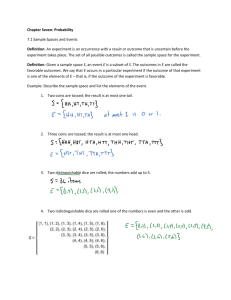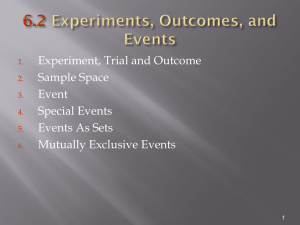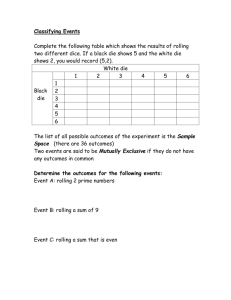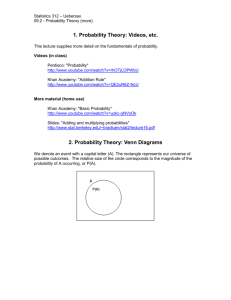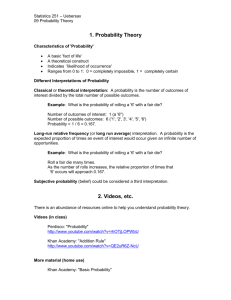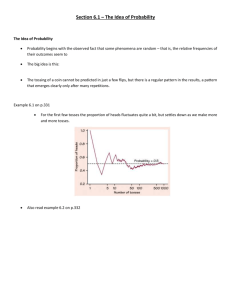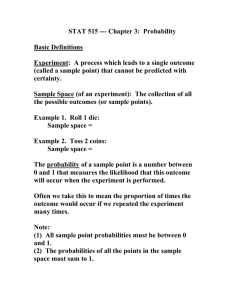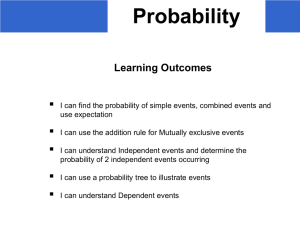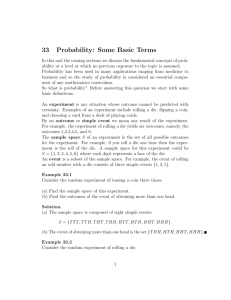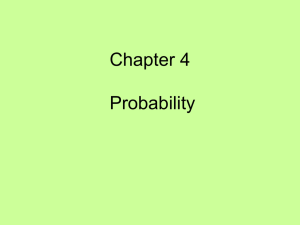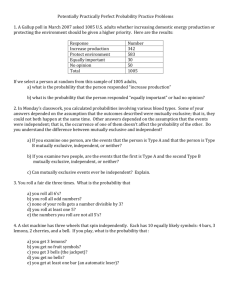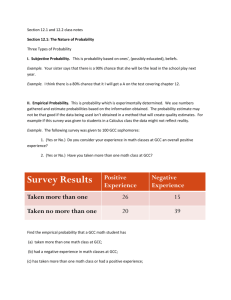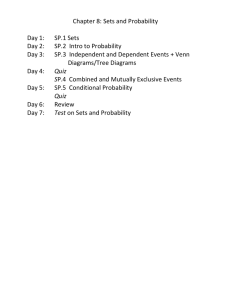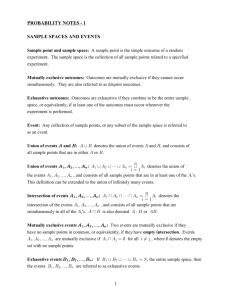Section 3.2-3.4 Handout for PPT
advertisement
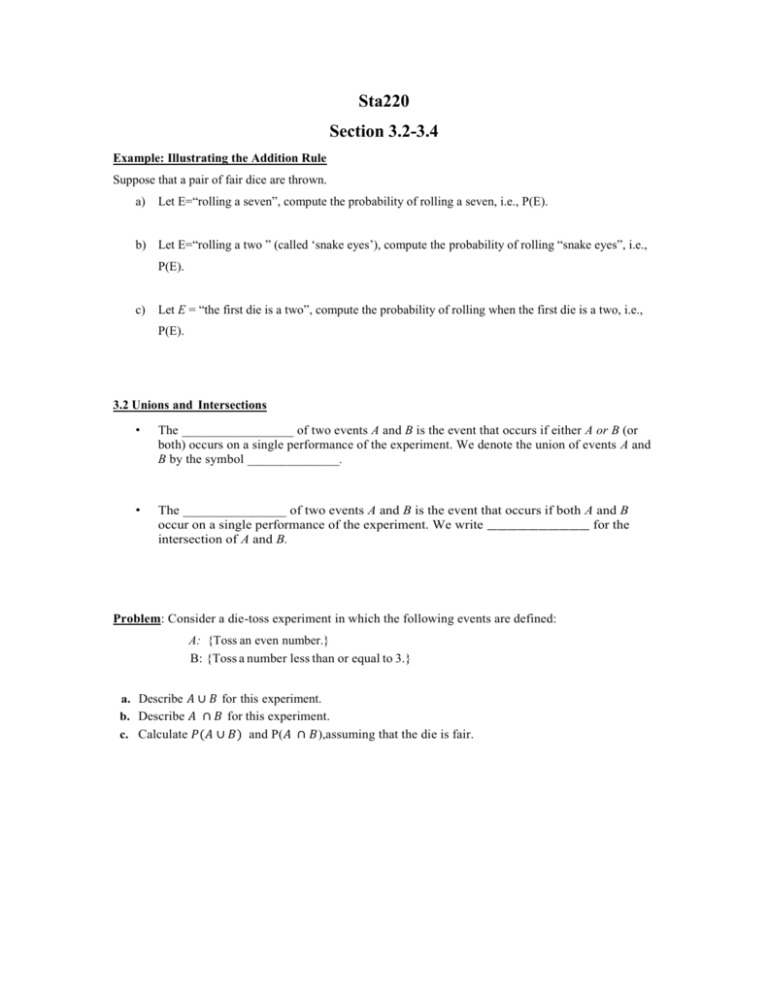
Sta220
Section 3.2-3.4
Example: Illustrating the Addition Rule
Suppose that a pair of fair dice are thrown.
a)
Let E=“rolling a seven”, compute the probability of rolling a seven, i.e., P(E).
b) Let E=“rolling a two ” (called ‘snake eyes’), compute the probability of rolling “snake eyes”, i.e.,
P(E).
c)
Let E = “the first die is a two”, compute the probability of rolling when the first die is a two, i.e.,
P(E).
3.2 Unions and Intersections
•
The _________________ of two events A and B is the event that occurs if either A or B (or
both) occurs on a single performance of the experiment. We denote the union of events A and
B by the symbol ______________.
•
The _______________ of two events A and B is the event that occurs if both A and B
occur on a single performance of the experiment. We write ____________________ for the
intersection of A and B.
Problem: Consider a die-toss experiment in which the following events are defined:
A: {Toss an even number.}
B: {Toss a number less than or equal to 3.}
a. Describe 𝐴 ∪ 𝐵 for this experiment.
b. Describe 𝐴 ∩ 𝐵 for this experiment.
c. Calculate 𝑃(𝐴 ∪ 𝐵) and P(𝐴 ∩ 𝐵),assuming that the die is fair.
Example: Family Planning Perspectives reported on a study of over 200,000 births in New Jersey
over a recent two-year period. The study investigated the link between the mother’s race and the age at
which she gave birth (called maternal age). The percentages of the total number of births in New Jersey,
by the maternal age and race classifications, are given in Table 3.4.
This table is called a two-way table, since responses are classified
according to two variables: maternal age (rows) and race (columns).
Define the following event:
A: {A New Jersey birth mother is white.}
B: {A New Jersey mother was a teenager when
giving birth.}
a. Find P(A) and P(B).
b. Find P(𝐴 ∪ 𝐵) .
c. Find 𝑃(𝐴 ∩ 𝐵).
Table 3.4
Percentage of New
Jersey Birth Mothers, by Age and Race
Race
White
Maternal
Age
(years)
White
Black
≤ 17
2%
2%
18-19
3%
2%
20-29
41%
12%
≥ 30
33%
5%
3.3 Complementary Events
The ________________ of an event A is the event that A does not occur -that is, the event consisting of all
sample points that are not in event A. We denote the complement of A by _________.
RULE of COMPLEMENTS
An event A is a collection of sample points, and the sample points included in A' are those not in A.
Example:
According to the American Veterinary Medical Association, 31.6% of American households own a dog.
What is the probability that a randomly selected household does not own a dog?
Example:
The data on the following page represent the travel time to work for residents of Hartford County, CT.
(a) What is the probability a randomly selected resident has a
travel time of 90 or more minutes?
(b) What is the probability a randomly selected resident has a
travel time less than 90 minutes?
Source: United States Census Bureau, 2000 Supplementary Survey
Example: Consider the experiment of tossing fair coins. Define the following event: A: {Observing
at least one head}.
a. Find P(A) if 2 coins are tossed.
b. Find P(A) if 10 coins are tossed.
3.4 The Additive Rule and Mutually Exclusive Events
· The Additive Rule:
· The probability of the union of events A and B is the sum of the probability of event A and the probability
of event B, minus the probability of the intersection of events A and B; that is
Example:
Suppose that there were 120 students in the classroom, and that
they could be classified as follows:
A: {A student with brown hair}.
B: {A student is a female}.
Brown
Not
Brown
Male
20
40
Female
30
30
What is the probability of choosing a student with brown hair or a
female?
Example:
Suppose that a pair of fair dice are thrown. What is the probability of the red die showing a 1 or
the green die showing a 1?
A: {red die shows a 1}.
B: {green die shows a 1}.
Problem
Hospital records show that 12% of all patients are admitted for surgical treatment, 16% are admitted for
obstetrics, and 2% receive both obstetrics and surgical treatment. If a new patient is admitted to the
hospital, what is the probability that the patient will be admitted for surgery, for obstetrics, or for both?
Mutually Exclusive Events
Events A and B are _________________________ if 𝐴 ∩ 𝐵 contains no sample points – that is, if A and
B have no sample points in common. For mutually exclusive events,
Probability of Union of Two Mutually Exclusive Events
If two events A and B are mutually exclusive, the probability of the union of A and B equals the
sum of the probability of A and the probability of B; that is
Example:
Suppose that a pair of fair dice are thrown. What is the probability the dice will add to be 3 or
add to be 6?
A: {sum of 3}.
B: {sum of 6}.
